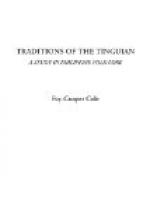[179] Piper sp.
[180] A headband of beads or gold.
[181] See p. 17, note 1.
[182] See p. 12.
[183] Don Carlos was evidently an Ilocano, for his language is Ilocano and his residence Vigan. Other points indicate that the story has many recent additions.
[184] The use of love charms is not confined to the Tinguian and their Ilocano neighbors, but is known also by the tribes of the Malay Peninsula. See Reyes, Folklore, Filipino, p. 50, (Manila, 1889); Skeat and Blagden, Pagan Races of the Malay Peninsula, Vol. II, pp. 232, 262. (London, 1906.)
[185] Antidesma ghesaembilla Gaertn.
[186] Ordinary lightning.
[187] See p. 24, note 1.
[188] See p. 18.
[189] Another name for Aponitolau.
[190] See p. 41, note 2.
[191] Ligi (Dagdagalisit) is now known by his true name.
[192] See p. 54, note 2.
[193] See p. 54.
[194] See p. 18, note 3.
[195] See p. 18, note 2.
[196] See p. 30, note 3.
[197] See p. 14, note 2.
[198] Another name for Ingiwan, who is really Aponitolau.
[199] See p. 12.
[200] As a sign of mourning.
[201] See p. 18, note 1.
[202] See p. 19, note 1.
[203] See p. 42.
[204] See p. 10, note 4.
[205] See p. 17.
[206] An insect.
[207] Ginteban was a woman from Baygan (Vigan) who had been captured by the bird.
[208] See p. 18.
[209] See p. 96, note 3.
[210] A fruit tree.
[211] See p. 18.
[212] See p. 30, note 3.
[213] The idea of a plant serving as a life or fidelity token was found in ancient Egypt, in India, and Europe. See Cox, an Introduction to Folk-Lore (London, 1904); Tawney, Katha Sarit Sagara (Calcutta, 1880, Vol. I, p. 86); Parker, Village Folk-Tales of Ceylon.
[214] See p. 18, note 1.
[215] See p. 17, note 1.
[216] A fruit.
[217] See p. 96, note 3.
[218] Lightning which is accompanied by a loud crash of thunder.
[219] See p. 19, note 1.
[220] See p. 16.
[221] See p. 30, note 3.
[222] See p. 18, note 1.
[223] See p. 16, note 6.
[224] Spirits.
[225] See p. 13, note 5.
[226] An evil spirit which lives in the air and makes a sound like the medium when she is summoning the spirits.
[227] The spirit’s word for world.
[228] A small bench made for the use of spirits and visiting mortals.
[229] See p. 105.
[230] See p. 63, note 1.
[231] The term used is al-ligan—the high watch house in the fields.
[232] One of the big stars.
[233] A different kind of star.




